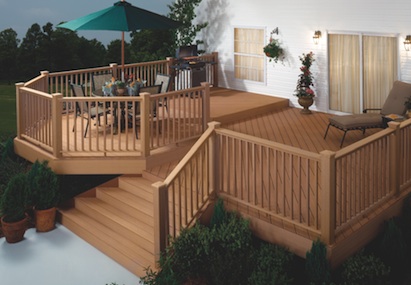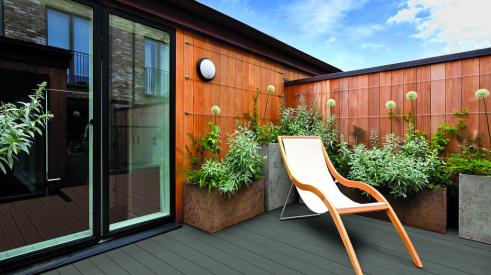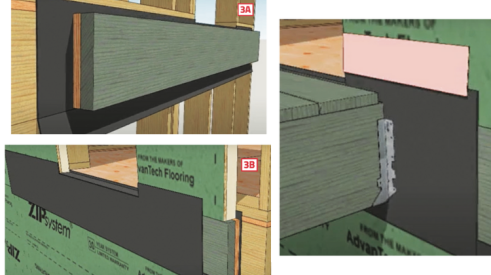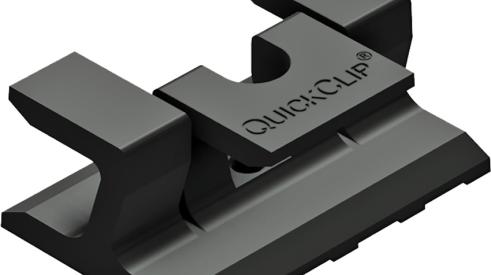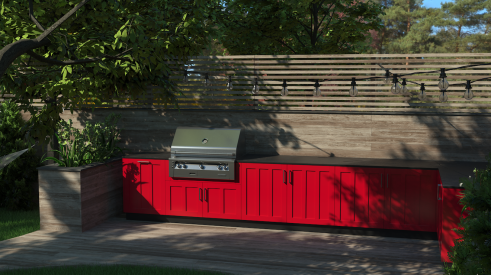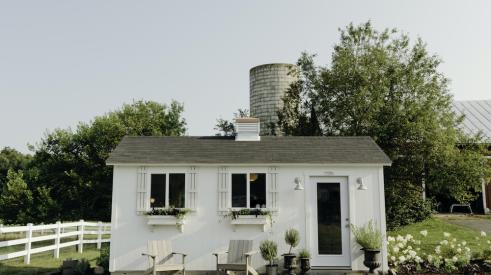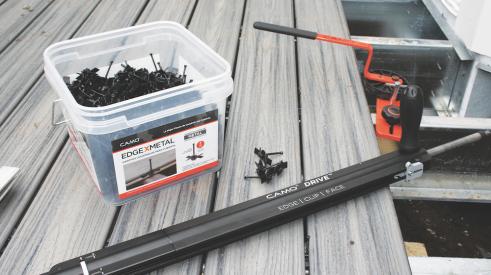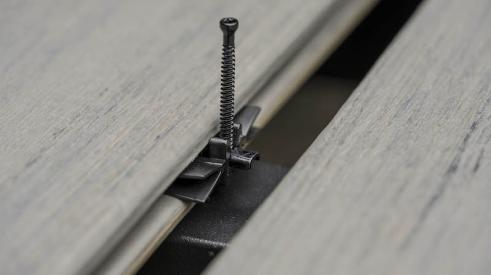With homeowners looking to make sensible changes to their homes, outdoor living is an easy way to make a big difference.
In warm weather people enjoy spending more time outdoors. A deck can provide the perfect spot for entertaining family and friends.
“Outdoor living is a very strong trend now,” notes Patti Pellock, CertainTeed Senior Marketing Manager. “People are not taking vacations but are staying home, so they are investing in their homes.” Remodelers can take advantage of this trend by designing and building attractive decks for their clients’ homes.
Decking material choices
Decks have traditionally been made of wood and “Wood is still the king when it comes to specifying and installing decking material,” says Chris Fox, Marketing Manager for Universal Forest Products. “The vast majority of all decks built are from lumber.” But over the last several years he has seen a shift to synthetics, including composite and PVC decking, which have been taking market share from lumber.
Perhaps one reason for this change is homeowners’ desire for ultralow maintenance. “This has been trending for the last two years using PVC decking and co-extruded composite decking, which features a cap stock outer layer,” notes Fox. Improved technology has led to reliable synthetic products that look just like wood, the appearance consumers want. Wood decking needs initial painting or staining to have a color other than gray once it weathers. Periodic repainting or restaining is required to retain its chosen color and prevent rot. Composite and PVC decks need only simple cleaning to keep their brand new look.
Another benefit is that composite decks do not warp, twist or splinter, notes Fiberon Director of Marketing Edie Kello. That fits well with remodelers’ desire for decking and railing products with a proven track record that are easy to install, Fox notes. “They do not want callbacks because there was an issue with the material,” he adds. Pellock said remodelers are focused on selecting deck products with “a wide range of performance, price and design options to meet their customers’ needs and fast, easy installation that does not compromise the quality and durability of the deck.”
A survey of remodelers done by Fiberon in June 2010 found more than 80 percent looked for durability when selecting decking materials. Other major selection factors were aesthetics, low maintenance, availability and mold resistance. Price was a greater concern for homeowners than for deck builders.
Style and color trends
In the current economy, “The average size deck has shrunk,” says Pellock. This is consistent with the increasing preference for smaller homes.
Another trend is using customized decking and railing options built with hidden fasteners for a smooth surface, says Kello. “Railings now offer more choices for balusters, including iron, baluster colors and glass with deck boards as a top rail,” she points out. The creativity of deck builders is shown in features like mixed colors in the decking and railing, multi-levels, design insets in the decking, built in benches, storage and other features that add quality space.
Many homeowners are specifying the newer tropical or exotic synthetic decking because it emulates the look of tropical hardwood without the upkeep, Fox notes. Those who want real tropical hardwood but who have environmental concerns can select Abaco tropical hardwood decking from Aljoma Lumber, a subsidiary of Universal. He says all wood species in this line originate from well-managed and sustainable forests under strict government guidelines and its importation must meet strict regulations set by U.S. Customs and the U.S. Department of Agriculture.
Tropical and multichromatic colors that look like ipe wood, cedar or dark mahogany or have variegated streaks are popular synthetic decking choices, Pellock agrees, with wood grain preferred over scratched or ribbed textures. These include CertainTeed’s EverNew LT cellular PVC decking line in Jatoba and Spanish Cedar. Installation of this product requires two fasteners at each end but only one fastener per joist, reducing fastener use by 40 percent and labor by 30 percent. By having a wood grain texture on both sides, CertainTeed’s EverNew PT may reduce waste up to 15 percent.
“The decking could match the home’s siding or trim or blend into the surroundings,” Pellock says. “Or it could color coordinate with landscaping or hardscaping around the deck.” Kello points out solid color composite decking has become much less popular since their multichromatic decking was introduced.
Remodelers can upsell by customizing decks with railings, accessories, lighting, ornamental post caps, and unique balusters. The colors for these features must also be considered. Some people might want darker decking with a white railing to match the house’s trim or want a deck color that goes with a cedar fence or teak furniture. “We have people who use one color of decking on the deck perimeter and another in the center,” Pellock points out.
Green aspects
While it may seem obvious that wood decking would be considered green, this concept was recently reinforced. On March 30, U.S. Agriculture Secretary Tom Vilsack announced his agency was promoting the use of wood in their building projects as a green building material strategy.
But synthetic decking products can also be green. Universal makes its Latitudes composite decking from a mixture of virgin and recycled high-density polyethylene and wood dust, which promotes product longevity and environmental friendliness. Each Latitudes board is made using Strandex technology which Fox says offers superior protection against UV degradation and water absorption.
Fiberon uses pre- and post-consumer content in manufacturing their products. In addition, they buy locally sourced raw materials, use rail transport where possible, recover 98.5 percent of all manufacturing material waste and use a closed loop water cooling system for zero water discharge.
Making the decision
Whether to install synthetic deck materials or wood decking depends on the homeowner’s budget, how the deck will be used and personal preference. “Homeowners usually do much research before meeting contractors and probably have a good idea of what’s available,” Pellock says.
Warranties can be a good selling point for decking. Many composite and PVC products come with 20 to 25 year stain and fade warranties consistent with the concept of ultralow maintenance. Some brands offer 25-year or even lifetime warranties against checking, splintering, delamination, rotting, structural damage from fungal decay or termites, checking, blistering or cupping. Pressure treated wood decking products offered by Viance come with a limited lifetime warranty against fungal decay and termite damage.
“If the homeowner prefers an all-natural product and doesn’t mind the typical upkeep that comes along with it, then pressure treated lumber or tropical hardwood lumber is the way to go,” Fox explains. “Typically composite decks cost at least three times as much as pressure treated decks,” although their maintenance costs over time will be lower. Contractors need to be sure homeowners understand the advantages and disadvantages of each type of decking material. When discussing decking choices, remodelers should bring an array of decking material samples and use a design program to show the homeowner how each product will look when made into a deck. When a remodeler adds an attractive deck to a home, it improves not only the home’s value but the homeowner’s quality of life.
Composite decking offers some advantages, but wood is still the most common choice
Add new comment
Related Stories
Pro's Picks: A Stylish Composite Decking
This pro shares a modern-look decking product with impressive performance
Top 100 Products 2022: Decks, Porches, & Railings
Products from AGS Stainless, Deckorators, SunTech, Fortress Building Products, Perma-Column, and Trex
How to Solve the Deck Ledger Problem in Fat Walls
Brick veneer and rigid exterior foam raise questions about deck ledger connections. We provide some answers.
Nova USA Wood Products: ExoDek QuickClip Fasteners
Hidden fasteners that automatically adjust your deck.
Top 100 Products for 2021: Decks, Porches and Railings
Products from AGS Stainless, Fortress Building Products, Camo, Fastenmaster, Fiberon, Deckorators and SunTech.
Pro's Picks: Danver Stainless Steel Cabinets
Stainless steel outdoor cabinetry that resists rusting while giving remodelers the look of interior kitchen design.
Work-From-Home Trend May Create Opportunity for Adding Shed Offices in Clients’ Outdoor Remodel
With more homeowners interested in working from home, backyard offices could be a solution for remote work.
Pro's Picks: Edgexmetal Clips, Camo Lever
A deck fastener system designed for metal framing that can save remodelers time and money.
Innovative Products: Camo EdgeXMetal Clips
A hidden clip for metal framing featuring a drill-point screw that can engage within two seconds



